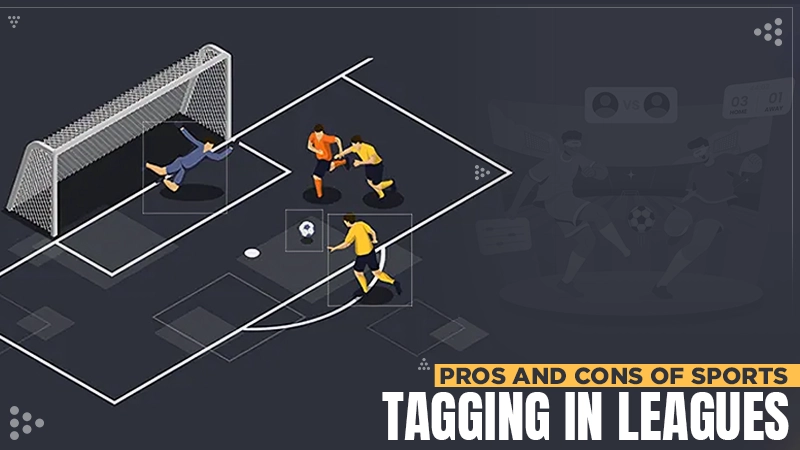Implementing Sports Tagging in Youth Leagues: Pros and Cons

Sports data tagging is a process to track the various events or actions taking place during a sports event.
Sports tagging is a technological advancement that has revolutionized sports analysis. This is important to identify several specific occurrences within the game like goals, fouls, passes tackles, and many other significant events.
Sports tagging services are not only restricted to the events happening in the game but also help identify and track the player’s position, movements, and skills.
Although it sounds like a promising procedure to derive statistical analysis of the game, sports tagging has its drawbacks. Let’s look at both the white and the black sides of data tagging services.
Pros and Cons of Sports Data Tagging
In the modern data-driven age many sports companies are increasingly turning to data tagging to gain a deeper insight into the player’s performance.
While tagging is dynamic and offers numerous benefits, it also presents some challenges that you should know before dipping your toes in it.
Here are the pros and cons of sports data tagging.
Pros of data tagging
- Enhanced analysis: Sports tagging enables in-depth analysis of the game and the player’s performance as well as the team tactics.
- Player development: Coaches and trainers can use the information derived from the tagging of a player to identify the areas of improvement and tailor the training programs to enhance the overall performance.
- Improved broadcasting: Along with the players that are tagging also helps the audience and enhances their viewing experience by providing real-time statistics and analysis during the broadcast.
- Fan engagement: Since broadcasting improves to a commendable level and makes things transparent for the audience, fan engagement also improves.
- Scouting and recruitment: Data tagging fill also helps in scouting potential recruits by providing a detailed inside in their performance and skills.
- Gaining an upper hand: Data tagging will present the strong and weak areas of a player. This information can be used to gain an upward hand against the competitors.
- Reinventing strategies: this process can also help identify whether the prevailing training strategies are working on the player. Dada tagging will also help to re-invent new strategies tailored according to the player’s needs.
Cons of Data Tagging
- Subjective data: the data from tagging can be subjective which may lead to inconsistencies in even labeling or categorization. This can affect the accuracy and reliability of the data.
- Cost and resources: Manual tagging can be time-consuming and labor-intensive but an automated tagging system may require substantial investment in technology and instructors.
- Data quality issues: the data from tagging cannot always be 100% accurate. The errors in accuracy in tagging can often lead to data quality issues which impact the validity and reliability of the whole system.
- Over Reliance on data:- you cannot overly rely on the tag data. The coaches and teams shouldn’t completely prioritize the statistical analysis over any other factors such as players’ intuitions, teamwork and other psychological factors of the game.
- Privacy concerns: collecting so much data obviously raises some privacy concerns, particularly regarding the personal information and performance of the athlete.
Sports Tagging Services
Several state-of-the-art sports tagging services will provide you with quality data of the game and the player’s performance including their strength and drawbacks.
- Sports video tagging services
This involves tagging and analyzing the video footage of the sports events to extract valuable insight into the player’s performance. This service mainly utilizes artificial intelligence and machine learning.
- Event tagging services
As the name suggests the services mainly focus on tagging specific events or actions that occur during a sports event for example goals, fouls, passes, shots, tackles, etc.
- Live player tracking
In life layer parking, mainly real-time videos are used for analysis and movement of a player during a match. This offers data immediately to the coaches for tactical plan formation and decision-making.
- Systematic segmentation
This is the most important service as it refers to the process of categorizing in organizing the tag data in a structured manner. This makes it easier for anyone to extract the data and analyze it for the development of the players.
- Player segmentation
This is similar to systematic segmentation but categorizes athletes based on various attributes, characteristics, and performance matrix. This is important in grading the player’s performance and in-depth knowledge of their strengths and weaknesses.
- Action identification
This refers to the process of identifying and categorizing the actions that occur during an event. This process involves the tagging of each action and is crucial for various purposes.
- Player position tracking
Again a very crucial type of sports tagging as it involves the use of technology to monitor and record the movements and positions of the players on the field or court. A detailed analysis of player positioning is just as significant as their skills.
- Players data annotation
This is the process of labeling and adding material data to specific attributes or even related to players during sports events. It helps in identification, event annotation, player attributes, and time stamps.
- Performance data analysis services
Analyzing the performance is the most significant step of sports training. The performance data analysis services involve the collection processing and interpretation of the data related to the athlete’s performance during a sports event.
- Game tagging in tracking
Game tagging in tracking involves systematic recording and analysis of various events’ actions in performance during a sports event. This data is extremely valuable for analyzing performance and developing strategic decision-making.
Future of Sports Tagging in Youth Leagues
As technology is advancing in every aspect of society, youth sports leagues are also embracing innovations like sports tagging to enhance player development and improve coaching techniques.
Future developments could see the integration of artificial intelligence and machine learning to predict player performance or suggest optimal training regimes.
As these technologies become more accessible and affordable their adoption in the youth league will increase and thus promote interactive learning, prevention of injuries, and enhanced player development.
Conclusion
Sports tagging offers numerous benefits in terms of analysis, strategy optimization, player development, and fan engagement. However, it also presents challenges related to subjectivity, cost, privacy, and data quality.
By addressing these challenges thoughtfully and implementing best practices in data tagging sports organizations can leverage the power of sports tagging to gain a competitive edge.















